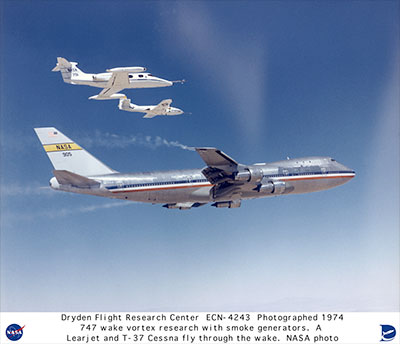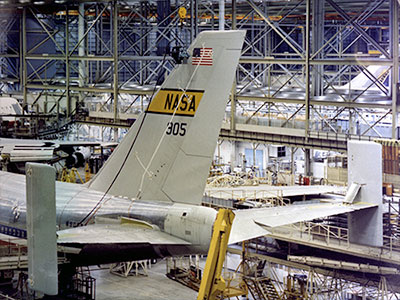|
Author
|
Topic: Shuttle Carrier Aircraft before modifications
|
LM-12
Member Posts: 3565
From: Ontario, Canada
Registered: Oct 2010
|
 posted 07-29-2021 04:51 PM
posted 07-29-2021 04:51 PM
  
Before the structural modifications, NASA's Shuttle Carrier Aircraft 905 (SCA-905) had three upper-deck windows on either side of the fuselage. The forward attach strut for the orbiter covered the third window. The second Shuttle Carrier Aircraft (SCA-911) was originally a Japan Air Lines 747 with ten upper-deck windows on either side of the fuselage.
|
LM-12
Member Posts: 3565
From: Ontario, Canada
Registered: Oct 2010
|
 posted 08-01-2021 12:52 AM
posted 08-01-2021 12:52 AM
  
I have seen a graphic that shows both SCA-905 and SCA-911 with the gold NASA tail band. SCA-905 had one in the photo above. Did SCA-911 ever have one? |
PeterO
Member Posts: 431
From: North Carolina
Registered: Mar 2002
|
 posted 08-01-2021 07:53 AM
posted 08-01-2021 07:53 AM
   
The earliest photo I found shows the worm logo. Since 911 wasn't acquired by NASA until the late 1980s, it's unlikely it ever had the yellow tail band logo. |
LM-12
Member Posts: 3565
From: Ontario, Canada
Registered: Oct 2010
|
 posted 08-01-2021 12:09 PM
posted 08-01-2021 12:09 PM
  
The graphic I was referring to can be seen right-of-center in this pan of the interior of 905 on display in Houston.I have never seen photos of 911 around the time it was delivered to NASA. I believe that was in 1988. 911 had the worm logo for its first ferry flight in 1991. |
Paul78zephyr
Member Posts: 730
From: Hudson, MA
Registered: Jul 2005
|
 posted 08-01-2021 04:54 PM
posted 08-01-2021 04:54 PM
  
The Jenkins book says N911NA was delivered to NASA 20 Nov 1990. |
LM-12
Member Posts: 3565
From: Ontario, Canada
Registered: Oct 2010
|
 posted 08-01-2021 06:34 PM
posted 08-01-2021 06:34 PM
  
I see the HAER No. TX-116-L NASA Shuttle document also has that Nov. 20, 1990 delivery date. It was the 911 modifications that began in 1988, as mentioned in the document: Boeing began modifications to the aircraft in 1988, at the Boeing Military Airplanes manufacturing facility in Wichita, Kansas... After the structural work was completed, the aircraft was delivered to Chrysler Technologies in Waco, Texas, for painting. NASA 911 was added to the NASA fleet on November 20, 1990, and for her maiden flight in May 1991, she delivered the new orbiter Endeavour (OV-105) to KSC. |
OV-105
Member Posts: 861
From: Ridgecrest, CA
Registered: Sep 2000
|
 posted 08-02-2021 03:43 PM
posted 08-02-2021 03:43 PM
   
911 never had the yellow tail stripe. It started with the worm and then I guess you would call it the open meatball(?) since there is no boarder around the logo. |
LM-12
Member Posts: 3565
From: Ontario, Canada
Registered: Oct 2010
|
 posted 08-03-2021 12:19 AM
posted 08-03-2021 12:19 AM
  
The open meatball is referred to as the "swoosh" logo in the NASA SP-2015-4556 Emblems of Exploration publication. |
heng44
Member Posts: 3521
From: Netherlands
Registered: Nov 2001
|
 posted 08-22-2021 03:40 AM
posted 08-22-2021 03:40 AM
   
Here is a photo of NASA 905 during modifications at Boeing in August 1976. |
LM-12
Member Posts: 3565
From: Ontario, Canada
Registered: Oct 2010
|
 posted 08-22-2021 07:44 AM
posted 08-22-2021 07:44 AM
  
As I understand it, the SCA modifications were done at two different Boeing facilities: NASA 905 in Everett, Washington, and NASA 911 in Wichita, Kansas. |
LM-12
Member Posts: 3565
From: Ontario, Canada
Registered: Oct 2010
|
 posted 08-24-2021 03:23 AM
posted 08-24-2021 03:23 AM
  
What did NASA 911 look like when it flew its first flight as an SCA on September 25, 1990? Did that flight occur before it was painted in the blue and white colours? |
OV-105
Member Posts: 861
From: Ridgecrest, CA
Registered: Sep 2000
|
 posted 08-25-2021 01:21 PM
posted 08-25-2021 01:21 PM
   
911 always had the the same SCA paint through its whole time. The only change was the tail worm to swoosh. |
LM-12
Member Posts: 3565
From: Ontario, Canada
Registered: Oct 2010
|
 posted 08-27-2021 09:46 AM
posted 08-27-2021 09:46 AM
  
This paragraph from a November 1990 NASA news release seems to indicate that NASA 911 was painted a few months after the September 25 flight. If that is the case, what did NASA 911 look like on that first SCA flight in September? After the structural work was completed, the aircraft was delivered to Chrysler Technologies in Waco, Texas, for its blue- on-white paint job. The freshly painted SCA was returned to Wichita November 13. |
PeterO
Member Posts: 431
From: North Carolina
Registered: Mar 2002
|
 posted 08-27-2021 02:17 PM
posted 08-27-2021 02:17 PM
   
Space Shuttle: Developing an Icon has a poster showing all of both Shuttle Carrier Aircraft's color schemes on page I-392. The book states that 911 was stripped to bare metal before being converted, and shows a photo in bare metal after conversion. This modeling forum posting also has a link to the poster, but the link is dead. I'll be happy to scan and post the poster with the proper citation. |
oly
Member Posts: 1254
From: Perth, Western Australia
Registered: Apr 2015
|
 posted 08-27-2021 11:06 PM
posted 08-27-2021 11:06 PM
   
The first 747-100s were built with six upper deck windows (three per side) to accommodate upstairs lounge areas. Later, as airlines began to use the upper deck for premium passenger seating instead of lounge space, Boeing offered an upper deck with ten windows on either side as an option. Some early -100s were retrofitted with the new configuration.Later modifications and variants had fuselage plugs inserted in areas forward and aft of the wing centre section to increase the fuselage length. SCA 905 (N905NA, Boeing 747-123, Serial No: 20107, Line No: 86) had three windows on the upper deck cabin prior to the SCA modifications, the Shuttle forward attach point area modifications removed the aft window, while SCA 911 (N911NA, Boeing 747-100SR-46, Serial No: 20781, Line No: 221) utilised the 10-window option (reduced to five post modification). Quoting NASA's Fact Sheet: Features that distinguish the two SCAs from standard 747 jetliners are: - Three struts with associated interior structural strengthening protrude from the top of the fuselage (two aft, one forward) on which the orbiter is attached.
- Two additional vertical stabilizers, one on each end of the standard horizontal stabilizer, to enhance directional stability.
- Removal of all interior furnishings and equipment aft of the forward No. 1 doors.
- Instrumentation used by SCA flight crews and engineers to monitor orbiter electrical loads during the ferry flights and during pre- and post-ferry flight operations.
... A flight crew escape system, consisting of an exit tunnel extending from the flight deck to a hatch in the bottom of the fuselage, was installed during the modifications. The system also included pyrotechnics to activate the hatch release and cabin window release mechanisms. The flight crew escape system was removed from the NASA 905 following the successful completion of the ALT program. |
LM-12
Member Posts: 3565
From: Ontario, Canada
Registered: Oct 2010
|
 posted 08-28-2021 12:48 AM
posted 08-28-2021 12:48 AM
  
quote:
Originally posted by PeterO:
This modeling forum posting...
That thread (on page 2) also has this close-up photo of NASA 911 that shows the forward attach strut. You can also see the five covered upper-deck widows on the right side of the fuselage. |













